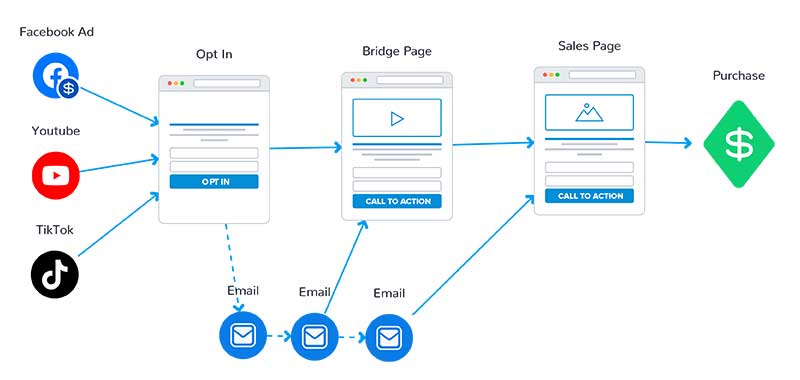When it comes to generating organic traffic, the answer to the question of can a funnel replace a website is no. However, if you have no desire to maintain a website to create organic traffic and want to focus solely on sales, then a funnel may be all you need.
Let’s dive a little deeper into the topic. I use both a funnel and a website in my online business. Using them both has been beneficial when it comes to affiliate marketing.
Funnel VS Website
First, I’ll provide some definitions of each in terms of using a funnel or a website for making money online with affiliate marketing.
How a Funnel Works for Affiliate Marketing
A funnel, often referred to as a sales funnel is a 1 – 2 page (sometimes more) that leads visitors towards the purchase of a good or service. A basic sales funnel is made up of a minimum of two pages: a squeeze page (opt-in) and a bridge page (thank you page.)
Here is a visual representation of a basic affiliate marketing sales funnel:

The job of the squeeze page (opt-in) is to collect your visitor’s contact details. At a minimum, you should be collecting an email address. I like to collect a first name as well so that I can add personalization to my email messages.
Speaking of which, each visitor who submits their contact details is added to your email database. This database may be included with the sales funnel software that you use or you may need to integrate a third-party email marketing software such as AWeber, GetResponse, ConvertKit, and others.
The second page of the funnel is referred to as the bridge page or thank you page. On this page, you can introduce your visitors to the product that you are recommending. This is where you can warm up the visitor by writing content about how the product helped you or explaining it in a video.
You should have a call-to-action button or link on your bridge page that is linked to your affiliate link. Some of your visitors will click your link and buy the product you’re promoting and some will not buy right away.
Regardless of the action that is taken, your visitors are in your email list so you can continue marketing to them using email messages.

How a Website Works for Affiliate Marketing
In most cases, a website is used to generate organic traffic. A website will be made up of articles (blog posts) and some of these articles will rank in the search engines with the help of SEO (search engine optimization.)
Unlike a sales funnel, a website can attract targeted visitors for years. The advantage of this is that you can send visitors to your funnel from within the content of your website.
A website and a funnel can work together to help grow your online business. That is exactly what I do. I use my website to send traffic to my funnel. It is a great way to automate lead generation.
Creating content for your website does require knowing a thing or two about SEO (search engine optimization.) SEO isn’t difficult to learn and learning the basics can bring positive results.
You can also use your website to promote multiple affiliate products. Having a website holds a lot of benefits and it’s well worth it to start one.
Choosing a Website Funnel Builder
In most cases, you’ll likely need funnel builder software to launch your sales funnel. There are many good ones to choose from. Here are some of the top choices:
- Clickfunnels
- Systeme.io
- Kartra
- Leadpages
The nice thing about some of these funnel builders is that they also include other features such as email marketing and courses. It can save money as you won’t have to pay for other third-party software.
Most sales funnel software offer a free trial. If you’re having trouble deciding on which one to use, you can sign up for a free trial and test out the features.
There is also the option to use a DFY (done for you funnel) that you can clone or one that is built for you using software or by someone else.
What is the First Page in a Funnel?
The first page in a funnel is essential to grabbing a visitor’s attention and capturing their contact information. This page is often referred to as a “squeeze page” or “opt-in page.”
One of the ways to capture a visitor’s attention and collect their contact details is by offering a free incentive or what’s called a “lead magnet.” A lead magnet can be in many forms such as:
- An ebook
- A video
- Audio file
- Email messages
Your lead magnet should offer some valuable tips or information related to the niche that you’re in. For example, if you are promoting a weight loss affiliate product, you could create a free ebook that has recipes or tips related to the product you’re promoting.
Or you could create a free course that teaches one aspect related to the product you’re promoting.
What are the Disadvantages of a Funnel?
The only disadvantage that I can think of when it comes to a sales funnel is that it cannot generate traffic on its own. A funnel isn’t designed to have tons of content pages that can attract visitors using SEO.
Instead, a funnel has a very specific purpose and that is to lead visitors towards the buying of a product. Therefore, it’s ideal to have as little distraction as possible and guide visitors with call-to-action buttons or links instead.
The sales tend to happen on the backend when your email subscribers receive your autoresponder messages.
Why Funnels are Better Than Websites
For the same reason stated above that is the one disadvantage, it is also an advantage. A sales funnel is focused on what it is designed to do which is to sell and make conversions.
A funnel automates the sales process. Once you have it set up properly, you can begin making semi-passive income by sending traffic to your funnel daily.
Another nice thing about funnels is that you don’t have to write content for them as you do with a website (blog.) That means less maintenance.
As time goes on, you may want to run tests and tweak your funnel. A good funnel can earn tens of thousands of dollars per month with a steady flow of traffic being sent to it.
The work you put into a funnel is in the form of generating steady traffic to it as well as nurturing your email list.
Nurturing Your Affiliate Marketing Funnel Email List
The magic of an affiliate marketing funnel is what happens behind the scenes. Remember that the job of your funnel is to collect visitor contact details as well as sell and convert.
Most people do not buy right away when you introduce them to the product you are recommending. This is where your autoresponder (email marketing) does the work for you.
Before you launch your funnel, you should have your autoresponder (the email marketing software you’re using) filled with several pre-written emails that will be sent out automatically according to the schedule that you choose.
These first emails will remind your visitors about the product by telling them more about the benefits, how it has helped you, and so on.
After your visitors go through your series of autoresponder messages, you can continue to message them by writing broadcast emails. A broadcast email is one that you can write and send out at any time and is not part of an autoresponder sequence.
In Conclusion
My final opinion is that a funnel doesn’t necessarily replace a website because they both do two very different things.
You don’t necessarily need to have a website if you choose to use a funnel and vice-versa. It is going to depend on how you want to promote affiliate products.
As mentioned above, I like using both a sales funnel and a website. I use my website (a blog) to send traffic to my funnel.
Organic traffic is some of the best traffic to send to a funnel because you don’t have to pay for it and it is targeted.
I hope this post has helped to clarify the difference between the two.

